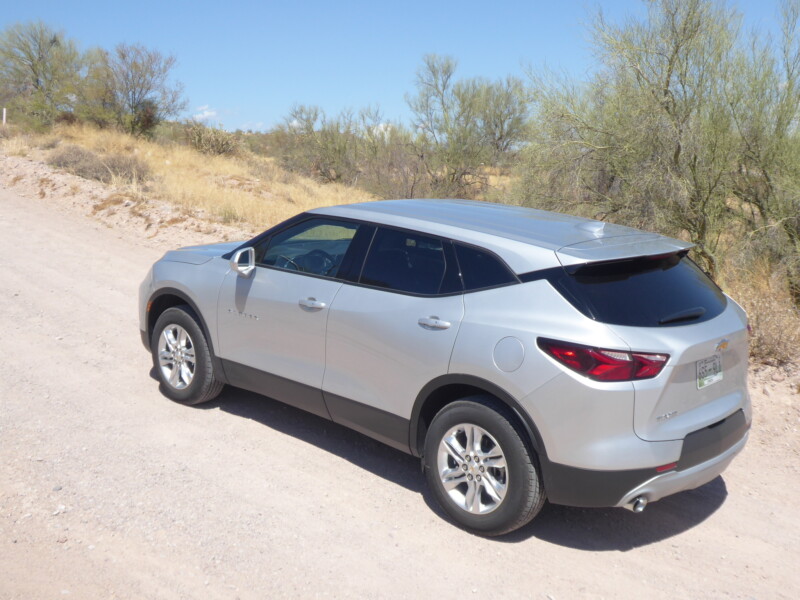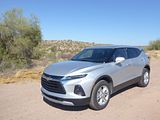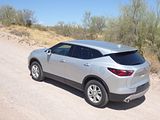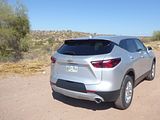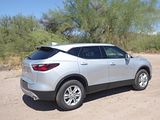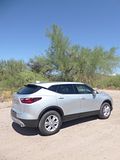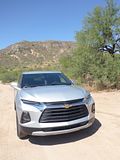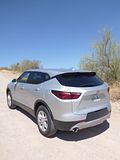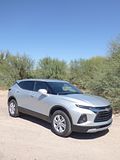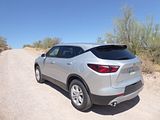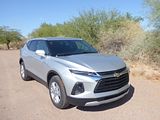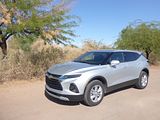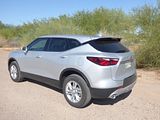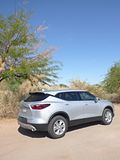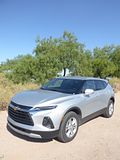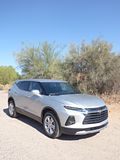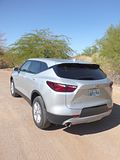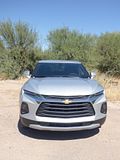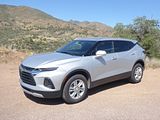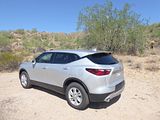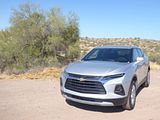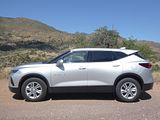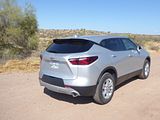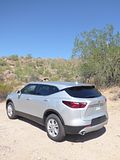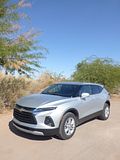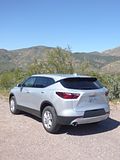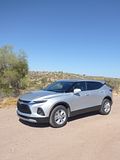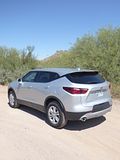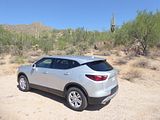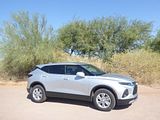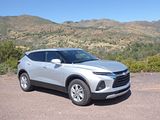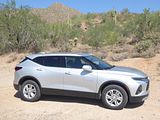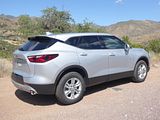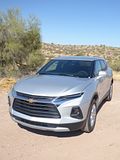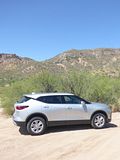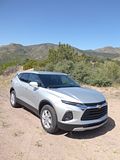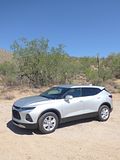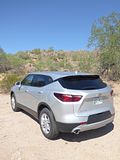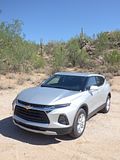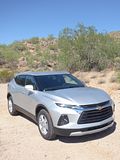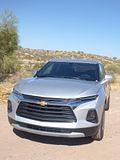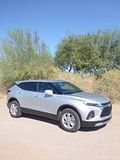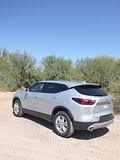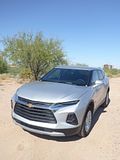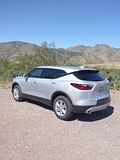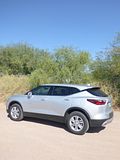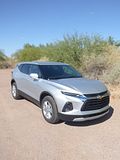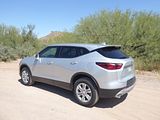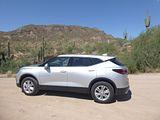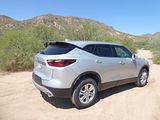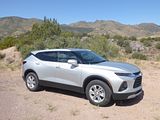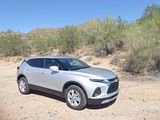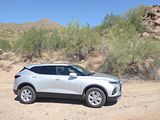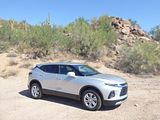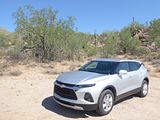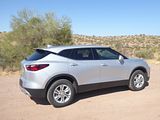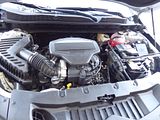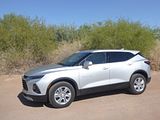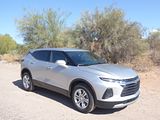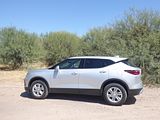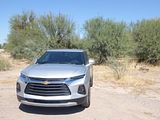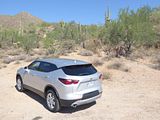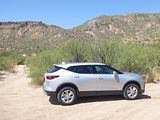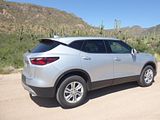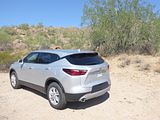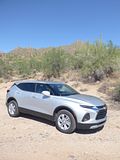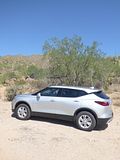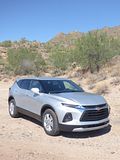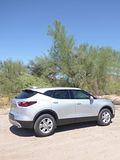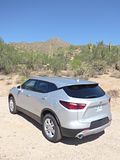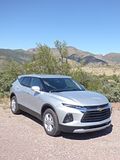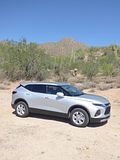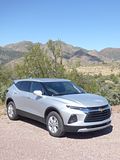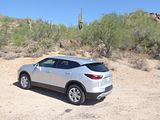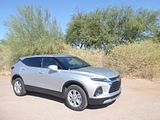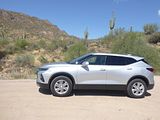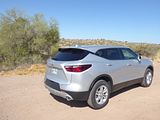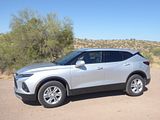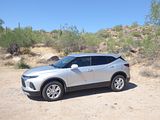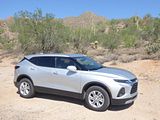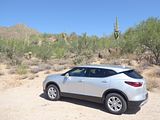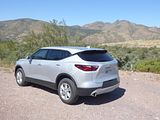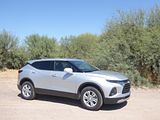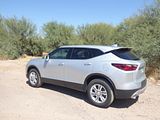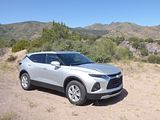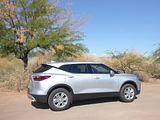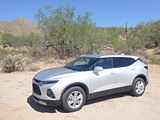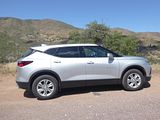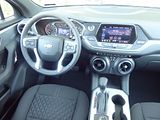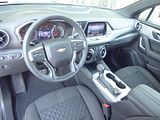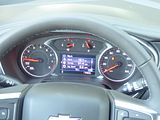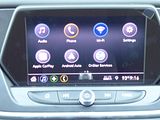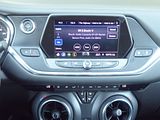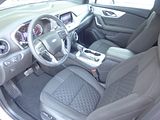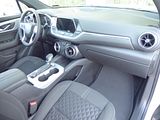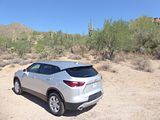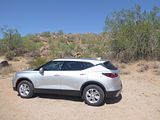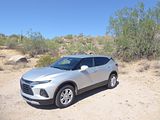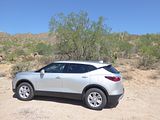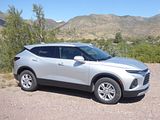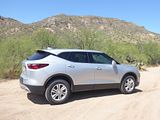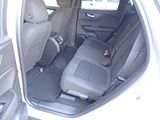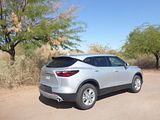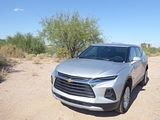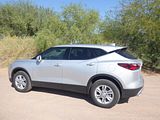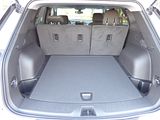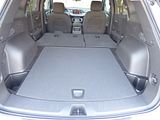If you study even some of the vast amount of material that is presented on the web in advance of attending one of the world’s major Auto Shows, there are likely to be few surprises when you get there in person. Indeed, usually, the issue tends to be that a couple of the things you’ve read about tend to get whisked away as soon as the press leave, so the general public does not get the chance to see them, but all the production launches tend to get good coverage and there are plenty of sites which also publish whole galleries of photos from the show itself. Having done my homework and kept uptodate with the news releases on several sites, I knew what to expect when I attended the Los Angeles Auto Show in December 2018. And this proved to be the case until I got to the Chevrolet stand. Taking pride of place there was a new Crossover-SUV vehicle, called the Blazer, which had not been mentioned by any of those sites I had studied so assiduously. With little else in the portfolio that was new, GM had clearly made a last-minute decision to bring the Blazer along, some months before it would go on sale. The fact that such a vehicle was in plan was not new news, and indeed the fact that the Blazer nameplate was being dusted off had also been widely communicated (leaked?), but this was the first opportunity to take a look at what was a fairly obvious addition to the Chevrolet range. Space had been made when the third generation Equinox had debuted a couple of years earlier, and it was notably smaller than before, now being aimed more at the Ford Escape and Toyota RAV4 than its predecessors had been, and the Traverse had remained as large and commodious as ever. A further hint came from the fact that another of the Lambda-platform vehicles, the GMC Acadia had also shrunk to be half a size smaller than it had been in its first generation, and clearly based on some different underpinnings from the new Traverse. So the Blazer was the answer, a 5-seater crossover, that shares its underpinnings with the GMC Acadia and Cadillac XT5, and which aims to find favour in the market by adopting a number of styling cues from the Chevrolet Camaro, thus trying to put the “Sporty” word back into SUV.
US market sales of the Blazer started in the middle of 2019, and the car is not a common sight on the roads there yet. Indeed, I did not recall seeing one until I arrived at Hertz’ Phoenix Airport facility when a couple were presented in the area right in front of the Gold Customer Office, a place usually reserved for stuff which is new or interesting or both. Hertz were trying to sell these at quite a premium compared to the going rate for what is just a regular-sized Crossover, so I wandered off and selected something else. A few days later, though, when car availability reached an even lower point than it had done on all the previous nights of this trip, after waiting around for nearly an hour as the handful of vehicles that arrived for rental were pounced upon instantly by other customers, a couple of Blazers arrived, and I was first to get to one of them, available at no upgrade cost at all, proving that patience sometimes is a real virtue. When I got in the Tenessee-plated model, I discovered that the odometer read just 6 miles, meaning that I was definitely the first person to rent it. It still smelled of new car, of course. The following morning, in the daylight, I could see what looked like muddy splash marks on the black trim on all four corners. Although I tried to wash this off, whatever it was remained stubbornly present, so I am not sure where this Blazer had been to get like that before anyone had driven it. Given the number of other protective bits of shipping material, such as bits of tape and stickers I found inside it, my guess is that the car famine meant that it got rushed into rental service before it had perhaps been intended it should be. None of this really mattered unduly, though, as what I wanted to find out was whether the distinctive looks of the Blazer were matched by a driving experience which would make it the must-have SUV of its class, or whether, like the smaller Equinox, it would leave no significant lasting impression at all.
First I had to work out which version of the Blazer I had received. There were no badges at all on the outside to tell me anything other than “Blazer”, and I confess that I was not familiar with the different engine options and models. The brief drive from the airport back to the hotel told me only that car seemed very smooth. A bit of web research elicited that there are two engines available, with the entry car having a 2.5 litre 4 cylinder unit that features in plenty of other current GM models, producing a not that impressive sounding 193 bhp and that there is also a 308 bhp 3.6 litre V6, both of them come coupled to a 9 speed automatic transmission. A quick look under the bonnet the following morning confirmed that I had indeed got a Blazer with the V6 engine, which is why it had felt so smooth the evening before. In fact there is a clue as in the instrument cluster there is a little display which says “V6”, which at times goes to read “V4”, presumably as a result of an active cylinder deactivation program. So, I got the top spec engine, but it was fairly clear that although the interior was nice enough, this did not feel like a top spec car. And indeed it proved not to be.
The Chevrolet Blazer is available in four main trim levels: L, Blazer, RS, and Premier. The Blazer trim name is slightly confusing, as it is broken down into three sub-trims based on upholstery type and engine size. The two lowest trims come standard with a four-cylinder engine. A V6 powers all other editions, and all-wheel drive is available with any of these models for around $3,000. Chevrolet offers several packages for the Blazer with upgrades such as a panoramic sunroof, wireless charging for your smartphone, or advanced safety systems. Sadly, most packages are only available on the upper trim levels, pushing your purchase price to a minimum of $38,000 or so before you can add on these appealing options. The Driver Confidence II package, for example, is the only way to get adaptive cruise control, yet it’s only available with the Blazer Premier. The good news for budget-minded shoppers is that all trim levels, including the $28,800 base L, come with an attractive set of standard features. If you want a stronger engine or a higher tow rating, plan to spend about $4,500 more to step up to a V6-powered Blazer. The base Blazer L trim level comes with dual-zone automatic climate control, a leather-wrapped steering wheel, proximity keyless entry, and push-button start. You can connect your phone to the Chevrolet Infotainment 3 interface via Bluetooth, Apple CarPlay, or Android Auto – and there are four USB ports onboard. This $28,800 edition comes only with a four-cylinder engine and front-wheel drive. The mid-level Blazer trim comes in three varieties, each building off the previous trim. The Blazer 2.5L Cloth ($32,300) trim features a four-cylinder engine, an eight-way power adjustable driver’s seat, and satellite radio. For $1,000, you can upgrade this to the Blazer 3.6L Cloth and get the more powerful engine, which is clearly what Hertz had bought. The V6 engine also comes in the Blazer 3.6L Leather. Upscale amenities for this $37,500 trim include perforated leather-appointed and heated front seats, a power liftgate, blind spot monitoring, rear cross traffic alert, and rear parking sensors. The performance-inspired Blazer RS has distinct exterior accents and sport-tuned steering and suspension systems. It also receives interior upgrades such as an 8-inch driver display, navigation, ambient lighting, a heated steering wheel, two additional USB ports, a cargo management system, and a hands-free liftgate. Prices start at $40,600 for the RS FWD and $43,500 for the RS AWD. Notable additions to the top-of-the-line Blazer Premier include an eight-speaker Bose premium sound system, leather-trimmed seats with suede microfibre inserts, ventilated front seats, and heated rear seats. Prices start at $42,700 for the front-wheel-drive Premier and $45,600 for the Premier AWD.
So now I knew what I was driving: a 3.6 L Cloth with the standard Front Wheel Drive. So how was it? Not bad, is the short answer. And here is the longer explanation. The engine is smooth, and very willing. As you might expect from a power output of 308 bhp, there is ample power to make the Blazer feel quite brisk and the 9 speed auto box does a good job at making the shifts without you be aware of them, and always appearing to be in the right ratio. Noise levels are generally low, thanks to the active noise cancellation feature. The indicator on the dash suggested that there were times when the engine was lightly loaded, especially when going downhill that only 4 cylinders where being used, but the transition to and from this was so utterly seamless that you would not know by any other means I would like to think that this helps fuel economy, and may be it does, but even so, the Blazer got through 6.88 US gallons in a test of 164 miles, meaning an average of 23.83 mpg US, or 28.48 mpg Imperial, which I did not think was that impressive.
Three driving modes are offered in front wheel drive Blazer models, with an additional two for the All Wheel Drive cars. These are selected from a rotary knob on the centre console. They are Tour, Sport and Snow/ice, with the additional AWD ones being for Tow/Haul and Off Road. I left it in Tour. The Blazer is better to drive than many cars of its ilk. The steering has the right level of assistance that retains feel and yet the car is not too heavy to punt along. There is plenty of grip and the handling on the twisty roads heading towards Payson meant that the Blazer could be hustled along with some enthusiasm, exploiting the fact that the engine was potent enough for the gradients not to be a problem. It is a Crossover with a higher centre of gravity than a passenger car, though, so you do drive it accordingly. The test car rode on 235/45 R18 wheels and, whilst quite firm, was comfortable on what generally are well-surfaced and smooth roads. There is good ground clearance so you could certainly head off the tarmac a bit, if you wanted, though noting that this lacks all-wheel drive, you might want to be cautious how far you went. There were no surprises from the brakes. An electronic parking brake is fitted and there is a small button for this on the dash to the left of the wheel. Visibility was good, though the swept up third side windows did mean that care was needed at oblique junctions. The door mirrors are set well back, so I found that when looking to the right you got a good view of the mirror casing itself as well, but the field of view was what I wanted and needed to see, so this was not an issue.
Chevrolet have made an effort with the interior to make it look less than utilitarian with leather facing the dash front, parts of the centre console and bits of the door casings. The gunmetal inlays don’t look like anything other than the cheap plastic that they are, though. The large round air vents are allegedly a reference to the Camaro, though it would be better if the central ones were higher up as where they are is great for cooling your elbow, but not much else. The instrument pack is quite simple with two large outer dials and the upper centre containing the fuel level and water temperature with the area below used for trip computer data, menus for which are cycled through using buttons on the right hand steering wheel spoke. Also on the wheel are bluetooth and cruise control controls. There are a pair of column stalks, whilst the lights, with an auto setting, operate from a rotary dial on the dash to the left of the wheel. the push button start is mounted up high to the right of the wheel, and then right of this you will find the infotainment screen. This is touch sensitive and is faster to respond than previous GM MyLink units have proved. Annoyingly, the XM radio subscription had not been activated, so it was AM or FM radio only, and the system also has Apple Car Play and Android Auto as well as car settings. Navigation was not a feature of the test car. Below this unit is a very long line of small switches for the dual zone automated climate control. You change the temperature target by rotating the central air vents. The USB ports are very prominent, mounted vertically, in the lower portion of the dash as opposed to be being buried away as is the case in most cars.
The test Blazer was not quite posh enough to have leather upholstery, so the seats were trimmed in cloth. Two different kinds, in fact, with a sort of quilted pattern used for the central section. The material used was quite coarse feeling, so whilst it looked OK, it was not exactly soft to the touch. There is 6-way electric adjustment of the driver’s seat, with the buttons set on the side to move it to where you want, but the front seat passenger gets none of this, with a bar under the seat for fore/aft and a lever on the side for backrest rake. Height adjustable seats feature, and there is a telescoping wheel, so there is plenty of opportunity to get the driving position you want. Unusually, I found that I had the front seat set as far forward as the motors would power it, and ideally would have liked to come forward a bit further than was possible. That said, the seat was comfortable and I was able to adapt my posture to cope with the limit to the seat travel.
Rear seat room is very spacious. Although the centre console unit, a large and bulky thing, protrudes quite well back, you would have to have unusually long legs for this to be an issue. Even with the front seats set well back, there is ample leg room here. Headroom is also generous, as a result of the taller body, and you can vary the angle of the asymmetrically split backrest. There is a drop down central armrest with a pair of cupholders in the upper surface. Oddments space comes from bins on the doors and pockets in the back of the front seats, and there are a couple of USB ports in the back of the centre console.
The boot is a decent size, with good length from front to back. There are plenty of hooks on the sides to help secure smaller items should you need to do so. There is a space saver under the floor and room around it for a few odds and ends. There are wells on either side of the main load area which would be useful for bits and pieces, too. More space can be created by folding down the rear seats. Release levers for the rear seats are mounted in the body sides as well as on the top of the seat backrests themselves, and the backrests simply drop down to create a long and flat load area. Inside the cabin there is a big glovebox, a cubby in front of the gearlever, one under the armrest, a small area on the side of the console on the passenger side and bins in the doors, ample for all the stuff that people may wish to have about them whilst en route.
Opinions in the US press seem to vary. Some have rated the Blazer highly putting it near to the top of the class, but others have been less impressed and put it near the bottom. Some of this derives from assessments of the higher spec models, where the costs make the car quite pricey and it would seem that the penalty for larger wheels makes the car particularly uncomfortable, and there is also a view that the 4 cylinder engine, whilst generally economical, is not really powerful enough. So it may well be that the spec of the test car, with the benefit of the more powerful V6 engine, but still at a sensible price is the sweet spot of the range. In this guise, it goes well, and is generally good to drive, though a Ford or Mazda would beat it for fun behind the wheel, and it is spacious enough inside, and the fit and finish is good enough. If you like the sporty and distinctive styling, it is definitely worth a look, and were it me thinking about a GM purchase, I would certainly favour it over the rather unmemorable GMC Acadia or even the rather ho-hum Cadillac XT5. It will be interesting to see how the market reacts.

